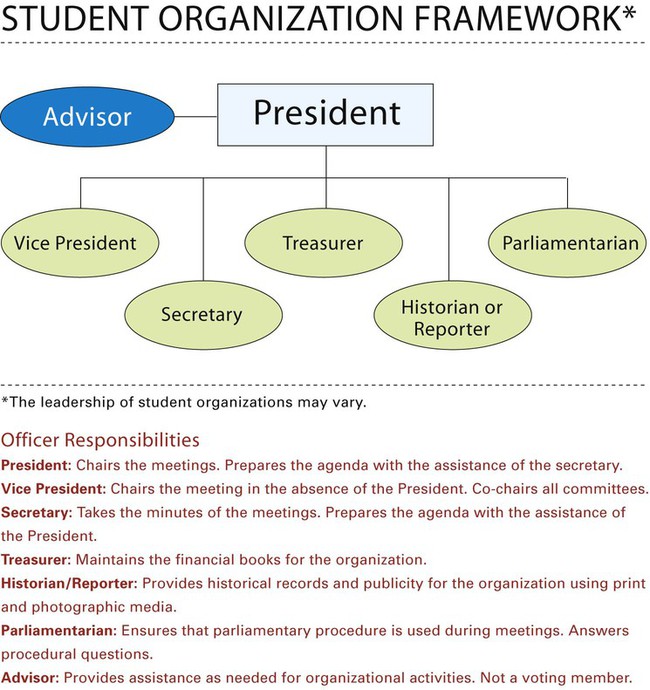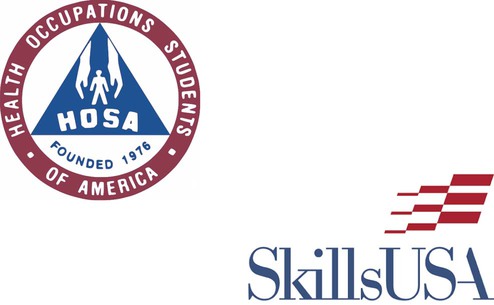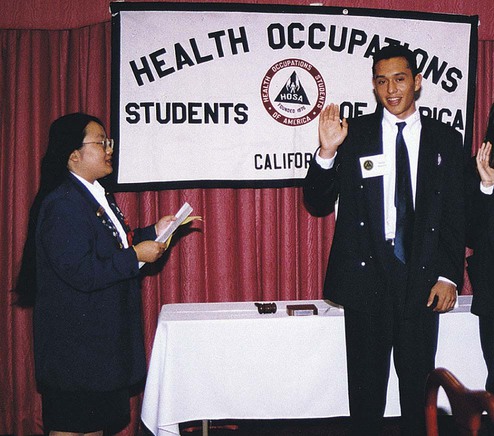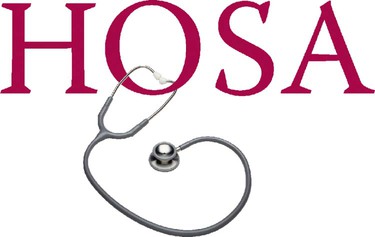Chapter 6 In an organization, a group of individuals unites to achieve a goal by cooperation and division of tasks among themselves. Groups can accomplish goals faster and more easily than individuals. An organizational chart shows the relationships among and the roles of the members (Fig. 6-1). Student organizations provide a means to learn the behavior and skills necessary to succeed in school, on the job, and as citizens. Each student member is responsible for the effectiveness and success of the student organization. Two national organizations that may be part of a health careers program include the Health Occupations Students of America (HOSA) and SkillsUSA (Fig. 6-2). SkillsUSA is open to students in all trade and industrial programs. SkillsUSA has chapters in all 50 states, four territories, and the District of Columbia (Box 6-1). HOSA is open only to students in health science (occupations) programs. Benefits of membership in a student organization include the exchange of information with others who have similar interests, an opportunity to sharpen skills through competition, and a way to develop leadership ability. Health care workers need leadership skills to provide better care. Many styles of leadership may be effective in different situations and may be practiced in student organization meetings (Table 6-1). Through organization membership, students develop programs and activities that build character, good citizenship, and a respect for ethical practices (Fig. 6-3). Confidence gained by assuming responsibility may lead to self-actualization. Student organizations promote and recognize individual and group achievements. TABLE 6-1 Founded in 1976, HOSA is a student-led organization in 47 states and Puerto Rico with more than 110,000 members (Fig. 6-4). HOSA is open to all students at the secondary and postsecondary or collegiate levels who are interested in a career in the health professions. HOSA is an integral part of many health science programs, providing students with an opportunity for leadership development and service learning (Box 6-2). HOSA allows students to connect with the health care community while preparing them for entry-level certification and further education. HOSA is only open to health occupations students. The HOSA National Competitive Events program provides a means of recognizing student knowledge and skills learned through health science education. Students compete in regional, state, and national competition in 57 areas (Box 6-3). Awards for competitors include scholarships for further education. Additionally, HOSA hosts leadership academies, including a Washington Leadership Academy to train state officers in leadership and advocacy. Parliamentary procedure is a set of rules for conducting a meeting in an organized and efficient manner. Robert’s Rules of Order is the basis for these rules and serves as the guide or authority for business procedures in many groups and organizations. Parliamentary procedure maintains a sense of order during meetings and ensures that all members have a chance to participate equally. The procedure is designed to simplify matters by allowing only one person to speak at a time and by discussing only one idea at a time. Decisions are reached through a process of motions, debate, and voting that ensures all members can be heard (Table 6-2). The vote of the majority determines the course of action, but the minority also has the right to be heard. TABLE 6-2 Parliamentary Procedure: Motions Used to Conduct Meetings
Employability Skills
 Define at least 10 terms relating to seeking a career in health care.
Define at least 10 terms relating to seeking a career in health care.
 Describe the purpose of a professional organization.
Describe the purpose of a professional organization.
 List three benefits of membership in a student organization.
List three benefits of membership in a student organization.
 List at least three reasons to use parliamentary procedure during an organization meeting.
List at least three reasons to use parliamentary procedure during an organization meeting.
 Identify the use of three motions of parliamentary procedure.
Identify the use of three motions of parliamentary procedure.
 Describe the purposes of the job application, resumé, portfolio, interview, and resignation letter.
Describe the purposes of the job application, resumé, portfolio, interview, and resignation letter.
 List at least five rules for completing a job application form.
List at least five rules for completing a job application form.
 Provide a positive response for at least five questions that might be asked in a job interview.
Provide a positive response for at least five questions that might be asked in a job interview.
 Prepare a resumé or personal data sheet.
Prepare a resumé or personal data sheet.
Professional Organizations
Student Organizations
Style
Description
Autocratic
Leader makes all the decisions, discourages creativity, and allows quick decision making and decisive action.
By example
Leader is a role model for participants.
Coaching
Leader explains decisions, asks for suggestions, and supervises projects.
Delegating
Responsibility for decisions is given to others.
Democratic
Participation is encouraged, decisions are made jointly, and everyone is considered equal; this may result in “tyranny of the majority” in which the minority never gets its way.
Directing
Leader provides instruction and supervision.
Laissez-faire
Nobody is in charge. Decision making is scattered. Creativity is encouraged. This style may lead to lack of action.
Situational
Leader adapts and changes styles depending on the matter at hand.
Supporting
Leader assists and shares decision making.
HOSA
Parliamentary Procedure
Motion
Can Interrupt Speaker?
Second Required?
Debatable?
Amendable?
Type of Vote Required
Purpose
Main
No
Yes
Yes
Yes
Majority
To introduce business
Refer to committee
No
Yes
Yes
Yes
Majority
To refer the matter to a committee
Approve minutes
No
Yes
Yes
Yes
Majority
To accept the minutes of a previous meeting
Amend a main motion
No
Yes
Yes
Yes
Majority
To change a motion
Table a motion
No
Yes
No
No
Majority
To wait to consider the matter
Adjourn
No
Yes
No
No
Majority
To end the meeting
Question of privilege
Yes
No
No
No
No vote
To give immediate attention to a problem
Division
No
Yes
No
Yes
No vote
To call for the vote to be verified
Point of order
Yes
No
No
No
No vote
To raise a parliamentary question ![]()
Stay updated, free articles. Join our Telegram channel

Full access? Get Clinical Tree


Employability Skills
Get Clinical Tree app for offline access









































































